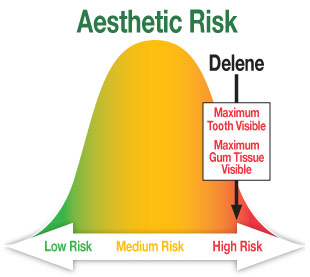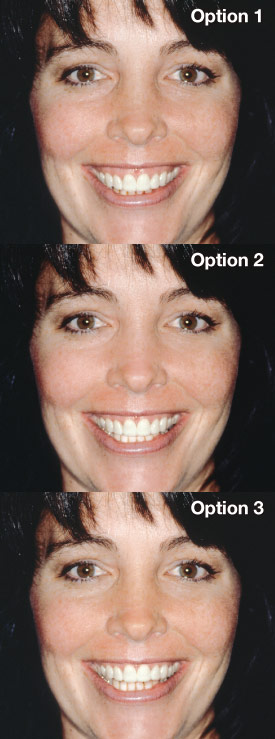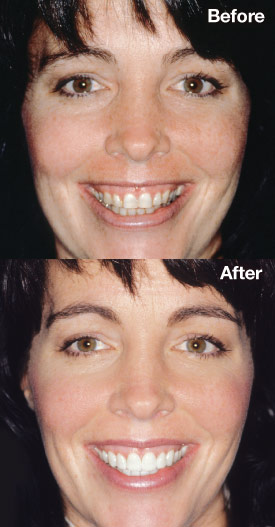Planning Successful Dental Treatment

(Continued)
Planning For Change

I knew I could repair the damage to Delene's tooth structure. With behavioral change on her part to improve hygiene, reduce sugars and acids in her diet, and increase her fluoride usage, risk for future decay could be reduced. Failing restorations (fillings) could be replaced in a way that would reinforce any remaining natural tooth structure to both stabilize and restore it. All this would lower biomechanical risk.
Adjusting Delene's bite by reshaping her back teeth with new fillings and crowns would restore and improve her biting and chewing function. Evening out the biting forces on her back teeth, thereby reducing the load taken by the front teeth, would stop the rapid wear she was experiencing. Porcelain veneers could lengthen her worn-down teeth. This would lower functional risk.
Three options were presented using computer imaging to improve her gummy smile. All of the options would give her slightly different aesthetic results by reducing the amount of gum tissue visible.
Option 1

Veneers on the front teeth to make them look longer would also draw attention away from the gummy smile; this would be combined with rebuilding the bite (back teeth) with crowns. This option would be the least expensive, but it might be less than ideal since it would not directly treat the gumminess.
Option 2
Periodontal plastic surgery using a procedure known as “crown lengthening” would remove some gum and bone tissue around the top teeth. The result would be less gum tissue showing in the smile with longer front teeth. Her teeth would then have to be filed down and crowned to bring them back to normal proportions. The net effect would be to move the teeth up within the framework of the face, and reduce the amount of visible gum tissue. While the result would look very pleasing, there would be some risk in that a significant amount of her natural tooth structure would have to be taken away, possibly leaving them susceptible to root canal problems later on.
Option 3
Orthognathic surgery (“ortho” – straighten; “gnathic” – jaw) could be used to move the upper jaw upwards, with the net effect (like Option 2) of moving the top teeth upwards within the framework of the face. Veneers and/or crowns would still be needed to lengthen the upper front teeth, as well as to rebuild the bite on the back teeth. This option would provide the best aesthetic outcome while reducing further compromises to tooth structure; but it would also come with the highest risk as the jaw would have to be surgically moved and repositioned under general anesthesia.
Decision Time
Delene and I fully discussed all of the risks and benefits of the three options, along with the outcomes she could expect if she were to do nothing at all. Once she felt she was informed enough to make her decision, she chose... Option 1.
 |
| The final result — improved length of front teeth, and back teeth restored to health. Note the computer simulation of option 1, selected by Delene as her treatment choice, is very close in appearance to the final result. |
Using a computer simulation, we were able to show Delene what the results of increasing the length of her front teeth would look like, and the effect it would have on reducing the gumminess of her smile. Since she responded positively to those computer images, we then gave her what's known as a “trial smile” so she could preview the results in her own mouth. This involved temporarily placing composite resin — a tooth-colored bonding material — onto her teeth to mimic the look she would get with veneers.
Once she received her actual veneers and crowns, Delene was delighted with the results.
From a dentist's perspective, I was pleased to be able to analyze her case effectively, to control or modify risk factors that were identified, and rebuild her bite to provide a result in a way that would predictably hold up over time. Best of all, through this systematic process, I could provide Delene with a result that she was happy with both aesthetically and functionally.
“I just felt that it changed everything about my smile,” she said. “I didn't worry about smiling anymore, I was very confident about it.”
Delene reports that while some years have passed since her full-mouth restoration, “it's held up over time super-well.” About Julia Roberts, Delene had this to say: “I could take her on any day!”

